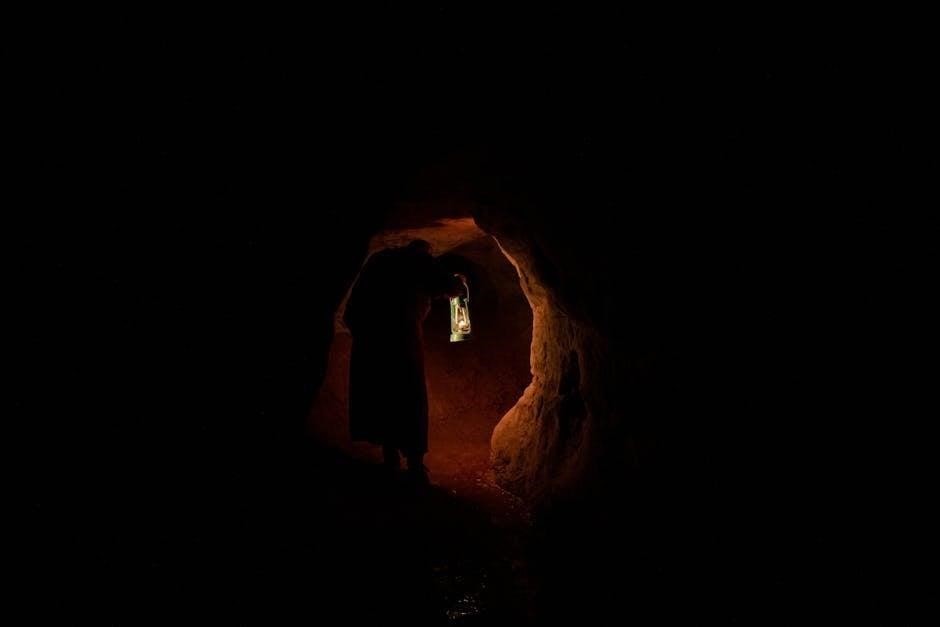The Karmic Guide Combo is a powerful and resilient strategy in Magic: The Gathering, revolving around the synergy between Karmic Guide and Reveillark. This combo is beloved for its adaptability and elegance, making it a favorite in competitive play.
1.1 Overview of Karmic Guide
Karmic Guide is a cornerstone card in the Karmic Guide Combo, renowned for its ability to return creature cards from the graveyard to the battlefield. As a 2-mana creature with flying, it offers exceptional versatility and value. Its ability to flash back for 5 mana makes it a reliable tool for recurring threats. Often paired with Reveillark, Karmic Guide excels at generating card advantage and fueling the combo engine. Its resilience to removal, thanks to its built-in protection, ensures it remains a consistent performer in competitive decks. The card’s synergy with other pieces, like Buried Alive, enhances its effectiveness in assembling the combo. Karmic Guide’s ability to be tutored for or entombed makes it a flexible inclusion in various strategies. Its role in the combo is indispensable, as it bridges the gap between graveyard setup and the explosive plays that follow.
Reveillark is a cornerstone card in the Karmic Guide Combo, offering unparalleled synergy with Karmic Guide and other combo pieces. As a 2W creature, it provides a versatile and efficient way to recur key cards, making it a linchpin in graveyard-based strategies. Its ability to return two target creature cards from the graveyard to the battlefield upon entering play is a game-changer, enabling the combo to reset and replay powerful threats repeatedly.
Reveillark’s resilience and evasion capabilities (thanks to its flying) make it a reliable and durable piece of the combo. It is often paired with Karmic Guide to create an infinite loop of recursion, allowing players to swarm the board with threats or generate insurmountable card advantage. Its moderate mana cost also makes it accessible in mid-game scenarios, ensuring the combo remains viable even as the game progresses.
One of Reveillark’s most underrated strengths is its ability to function as both a combo enabler and a standalone threat. This flexibility ensures that even if the combo is disrupted, Reveillark can still contribute to the game’s outcome. Its synergy with fetch lands and other graveyard manipulation tools further enhances its effectiveness, making it a staple in competitive and casual builds alike.

Core Combo Pieces
The Karmic Guide Combo relies on three central components: Karmic Guide, Reveillark, and Buried Alive. These pieces work harmoniously to enable recursive value and board control. Buried Alive tutors for both creatures, allowing the combo to activate with minimal mana investment, ensuring synergy and efficiency;
2.1 Karmic Guide and Reveillark Synergy
The synergy between Karmic Guide and Reveillark is the heart of this combo, creating a potent loop that ensures resilience and card advantage. Karmic Guide, a 3-mana creature, can sacrifice itself to return a creature from the graveyard to the battlefield. When paired with Reveillark, a 4-mana creature that returns two creatures when it enters the battlefield (provided they have power less than or equal to the number of Faerie creatures you control), the interaction becomes incredibly powerful.
By sacrificing Karmic Guide to return Reveillark, you can then use Reveillark to bring back Karmic Guide and another creature, creating an infinite loop. This loop not only generates card advantage but also sets up a game-winning board state. The ability to repeatedly retrieve these creatures from the graveyard makes the combo both resilient and flexible, allowing it to adapt to various metagames and disruption attempts.
This synergy is the foundation upon which the rest of the combo is built, enabling players to recover from setbacks and maintain momentum throughout the game.
2.2 Role of Buried Alive
Buried Alive plays a pivotal role in the Karmic Guide Combo, serving as a reliable tutor to find and assemble the core pieces. This spell allows you to search your library for up to three creature cards, making it an invaluable tool for ensuring you have Karmic Guide and Reveillark in your graveyard or hand. By casting Buried Alive, you can directly set up the combo, bypassing the need to draw into your pieces naturally. Its mana cost of 3BB makes it accessible in the mid-game, where the combo typically begins to execute. One of the key advantages of Buried Alive is its ability to function even if your hand is empty, ensuring you can still progress toward your game plan. Additionally, pairing Buried Alive with cards like Entomb or Body Launderer can reduce its effective cost, making it even more efficient. This spell is a cornerstone of the combo’s consistency, ensuring you can reliably find and deploy your win condition.

Mana Considerations
Mana management is crucial for the Karmic Guide Combo. Fetch lands like Flooded Strand and Marsh Flats provide consistent mana fixing, while artifacts such as Sol Ring and Mana Crypt accelerate early-game plays, ensuring the combo pieces are cast on time.
3.1 Fetch Lands for Mana Fixing
Fetch lands are a crucial component of the Karmic Guide Combo, serving as the backbone for reliable mana fixing. These lands, such as Flooded Strand, Woodland Cemetery, and Misty Rainforest, allow you to fetch specific dual or shock lands, ensuring you have the necessary colors to cast your combo pieces. Dual lands like Temple Garden and Overgrown Tomb are particularly valuable, as they provide multiple colors without the need for additional mana acceleration. The ability to fetch these lands ensures consistency, especially in the early game when setting up the combo is critical. Fetch lands also enable flexibility, as they can be used to find the exact colors needed for spells like Buried Alive or Karmic Guide. By incorporating a mix of fetch and dual lands, you can maintain a stable mana base while minimizing color issues. This setup is essential for executing the combo efficiently and ensures that your mana development aligns with the strategic needs of the game.
3.2 Artifacts for Acceleration
Artifacts play a pivotal role in accelerating the mana development necessary to execute the Karmic Guide Combo efficiently. Cards like Sol Ring and Arcane Signet provide immediate mana acceleration, enabling the pilot to cast key spells earlier in the game. These artifacts are particularly valuable in ramping up to the mana required for Buried Alive, the linchpin of the combo. Additionally, artifacts such as Mana Crypt and Moxen (e.g., Mox Sapphire, Mox Jet) offer explosive mana acceleration, allowing for faster setup and execution of the combo.
The synergy between these artifacts and the combo pieces ensures that the deck can maintain a consistent tempo, even in the face of disruption. By incorporating a mix of artifact-based mana acceleration, the Karmic Guide Combo becomes more resilient and adaptable, capable of performing well in a variety of metagames. This makes artifacts an indispensable component of the deck’s overall strategy.

Game Plan Strategy
The strategy involves an early game setup, mid-game execution, and late-game combo activation. Initially, focus on developing the board and setting up key pieces. Mid-game, find and protect combo components. Finally, execute the combo to win, leveraging synergy and protection effectively.
4.1 Early Game Setup
The early game in the Karmic Guide Combo revolves around establishing a strong foundation for executing the combo. Mana acceleration is critical, so prioritizing fetch lands like Verdant Catacombs or Flooded Strand ensures consistent mana fixing. These lands allow you to fetch the necessary basic lands to cast your combo pieces smoothly.
Artifacts such as Sol Ring or Arcane Signet are invaluable for accelerating your mana development. They enable you to cast key spells earlier, such as Buried Alive, which is essential for assembling the combo. Protecting your graveyard is also crucial during this phase, as opponents may attempt to disrupt your strategy with cards like Rest in Peace or Grafdigger’s Cage.
Deploying creatures like Karmic Guide or Reveillark early can provide value, but timing is key. Avoid committing too many resources until you have a clear path to execute the combo. Strategic land deployment and light creature play set the stage for a seamless transition into the mid-game, where the combo can be unleashed effectively.

4.2 Mid-Game Execution
By the mid-game, the focus shifts to setting up the combo pieces while maintaining board control. With your mana base established, you can begin tutoring for critical cards like Buried Alive or Karmic Guide using artifacts or fetch lands. Protection spells should be held to safeguard your graveyard from disruption.
Optimal sequencing involves casting Buried Alive to grab both Karmic Guide and Reveillark, ensuring you can activate the combo in the following turns. If opponents threaten your setup, consider using utility creatures like Carrion Feeder to clear the way. Artifacts like Sol Ring or Mana Crypt accelerate your mana development, allowing earlier access to your combo.

Board presence is crucial; use creatures to block or trade effectively, buying time to assemble your pieces. Fetch lands remain vital for fixing your mana, ensuring you can cast spells as needed. The mid-game is about balance—protecting your resources while advancing toward the combo finish.
4.3 Late Game Combo Activation
In the late game, the Karmic Guide Combo reaches its peak potential, leveraging the board state and resources accumulated earlier. With Karmic Guide and Reveillark in play, the combo can recursively return creatures from the graveyard to the battlefield, creating an insurmountable advantage. The key is to ensure that both pieces are protected and that mana is efficiently managed to facilitate the loop.
Once activated, the combo can generate infinite creature enters-the-battlefield triggers, enabling game-winning plays such as generating infinite mana or dealing lethal damage. The inclusion of Carrion Feeder or other sac outlets further enhances the combo’s reliability, allowing for consistent execution even under pressure. Proper timing and protection are critical, as opponents will often target the combo pieces once they recognize the threat.
By this stage, the deck’s graveyard should be well-stocked with creatures, enabling the combo to function seamlessly. The late game activation is where the Karmic Guide Combo truly shines, offering a satisfying and powerful conclusion to the game plan.

Protective Measures
Protecting your graveyard is crucial, as exile effects can disrupt the combo. Consider including Carrion Feeder to exile creatures upon death and fetch lands to ensure mana consistency, safeguarding your strategy against interference.

5.1 Graveyard Protection
Protecting the graveyard is a critical component of the Karmic Guide Combo, as the strategy relies heavily on maintaining access to key creatures like Karmic Guide and Reveillark in the graveyard. Opponents often target these cards with removal spells or exile effects, which can disrupt the combo’s execution. To mitigate this risk, players employ several graveyard protection measures.
Tormod’s Crypt and Rest in Peace are popular choices, as they provide a permanent solution to prevent graveyard interaction. These cards can be activated during critical moments to shield the graveyard from disruptive spells. Additionally, spells like Phyrexian Boon or Witchbane Orb can offer supplementary protection, though they may not be as robust in all matchups.
Timing is crucial when deploying these protective measures. Activating them too early can tip your hand to the opponent, while waiting too long may allow them to disrupt the graveyard before the combo is assembled. Balancing these factors is essential for ensuring the combo’s success. Graveyard protection not only safeguards the combo pieces but also buys time to set up the necessary mana and board state for activation.
5.2 Alternative Combo Pieces
While Karmic Guide and Reveillark form the core of the combo, incorporating alternative pieces can enhance flexibility and redundancy. One notable addition is Carrion Feeder, a utility creature that can sacrifice other creatures to generate value. This is particularly useful in setups where the primary combo pieces are disrupted. Another option is Body Snatcher, which can fetch specific creatures from the graveyard, providing an additional layer of protection and reliability. These alternatives ensure the combo remains functional even if key components are missing or interacted with. Additionally, including creatures like Saffi Eriksdotter can act as a backup win condition, synergizing with the graveyard-centric strategy. By diversifying the combo’s components, players can adapt to various metagames and increase their chances of success. This approach also makes the deck more resilient to targeted removal or graveyard hate. Ultimately, alternative pieces like these maintain the combo’s integrity while offering new avenues for victory.

Utility and Flexibility
The Karmic Guide Combo offers exceptional utility through cards like Carrion Feeder, enabling creature sacrifices for recursive value; Optimize your land base with fetch lands to ensure consistent mana access, enhancing overall flexibility and resilience in various game scenarios.
6.1 Role of Carrion Feeder
Carrion Feeder plays a pivotal role in the Karmic Guide Combo, primarily as a sacrificial engine to enable recursive value. Its ability to sacrifice a creature and gain a +1/+1 counter makes it an invaluable asset for maintaining board presence and generating card advantage. In the context of the combo, Carrion Feeder is often used to sacrifice creatures like Karmic Guide or Reveillark, allowing them to be recursed repeatedly. This interaction is crucial for creating an infinite loop, where the combo can be activated multiple times to flood the board with threats.
Moreover, Carrion Feeder’s low mana cost and versatility make it an excellent utility piece in the late game. It ensures that even if the primary combo pieces are removed, the deck retains a way to generate pressure and close out the game. Its synergy with other combo enablers like Buried Alive further solidifies its importance, as it provides a reliable way to recover from disruptions. Overall, Carrion Feeder is a cornerstone of the Karmic Guide Combo’s resilience and flexibility in competitive matchups.
6.2 Land Base Optimization
Optimizing the land base is crucial for the Karmic Guide Combo, as it ensures consistent mana development and flexibility. Fetch lands like Misty Rainforest and Verbotene Orakel are essential, providing the ability to fetch specific lands and maintain a balanced mana curve. Dual lands such as Overgrown Tomb and Temple Garden are also key, as they offer access to multiple colors without relying on basic lands.
- Fetch Lands: These enable early-game acceleration and mid-game consistency, ensuring you can cast combo pieces and protective spells when needed;
- Dual Lands: They provide redundancy and allow for smoother transitions between colors, reducing reliance on basic land draws.
- Utility Lands: Include cards like Gaea’s Concourse to add flexibility and resilience, especially in matchups where land destruction is a threat.
By combining fetch lands, dual lands, and utility lands, the deck achieves a balance of consistency and resilience, ensuring the combo can be assembled efficiently across various game states. This optimization also supports the combo’s ability to adapt to different metagames and strategies.

Sideboarding and Adaptation
Sideboarding with the Karmic Guide Combo involves matchup-specific adjustments, such as adding graveyard hate or artifact removal. Tutors like Mystical Tutor or Demonic Tutor enhance flexibility, while cards like Rest in Peace or Wear//Tear can neutralize threats. Adaptation is key to maintaining combo viability.
7.1 Matchup-Specific Adjustments
When facing different opponents, the Karmic Guide Combo requires tailored adjustments to maximize its effectiveness. Against control decks, which often rely on counterspells and graveyard hate, it’s crucial to include additional protective measures like Rest in Peace or Tormod’s Crypt in the sideboard. These cards ensure the combo’s resilience against common interruptions.
For combo-heavy matchups, prioritizing speed is essential. Including Demonic Tutor or Diabolic Intent can accelerate the assembly of the core pieces. Conversely, against midrange decks that balance threats and removal, incorporating wishboard cards like Karakas or Iona, Shield of Emeria can disrupt their plans while safeguarding the combo.
In creature-dominated matchups, adding Swords to Plowshares or Path to Exile to the sideboard helps clear the board of potential threats. These adjustments ensure the Karmic Guide Combo remains adaptable and formidable across diverse metas, making it a versatile and reliable choice for competitive play.
7.2 Tutors for Flexibility
Tutors are essential for adding flexibility to the Karmic Guide Combo, enabling you to find specific pieces when needed. Cards like Demonic Tutor and Vampiric Tutor allow you to search for Karmic Guide or Reveillark, ensuring you can execute the combo even under pressure. These tutors are particularly valuable in matchups where disruption is heavy, as they provide consistency. Additionally, Mystical Tutor can be used to find an anthem or protection spell, safeguarding your combo from interference. Tutors also help in finding Buried Alive, which is crucial for setting up the combo quickly. By incorporating tutors, you gain the ability to adapt to different game states and increase the overall resilience of your strategy. This flexibility ensures the Karmic Guide Combo remains viable across a wide range of metagames and playstyles. Tutors are a cornerstone of competitive combo decks, and their inclusion here underscores the combo’s adaptability and power.
